Page 337 of 400
342 5−2. Steps to take in an emergency
Turn the hold−down nuts counter−
clockwise with the wheel nut
wrench and remove them.
Replacing a flat tire
Chock the tires.
Flat tireWheel
chock
positions
Front
Left−
hand
sideBehind the
rear right−
hand side
tire
Right−
hand
sideBehind the
rear left−
hand side
tire
Rear
Left−
hand
sideIn front of
the front
right−hand
side tire
Right−
hand
sideIn front of
the front
left−hand
side tire
Page 342 of 400
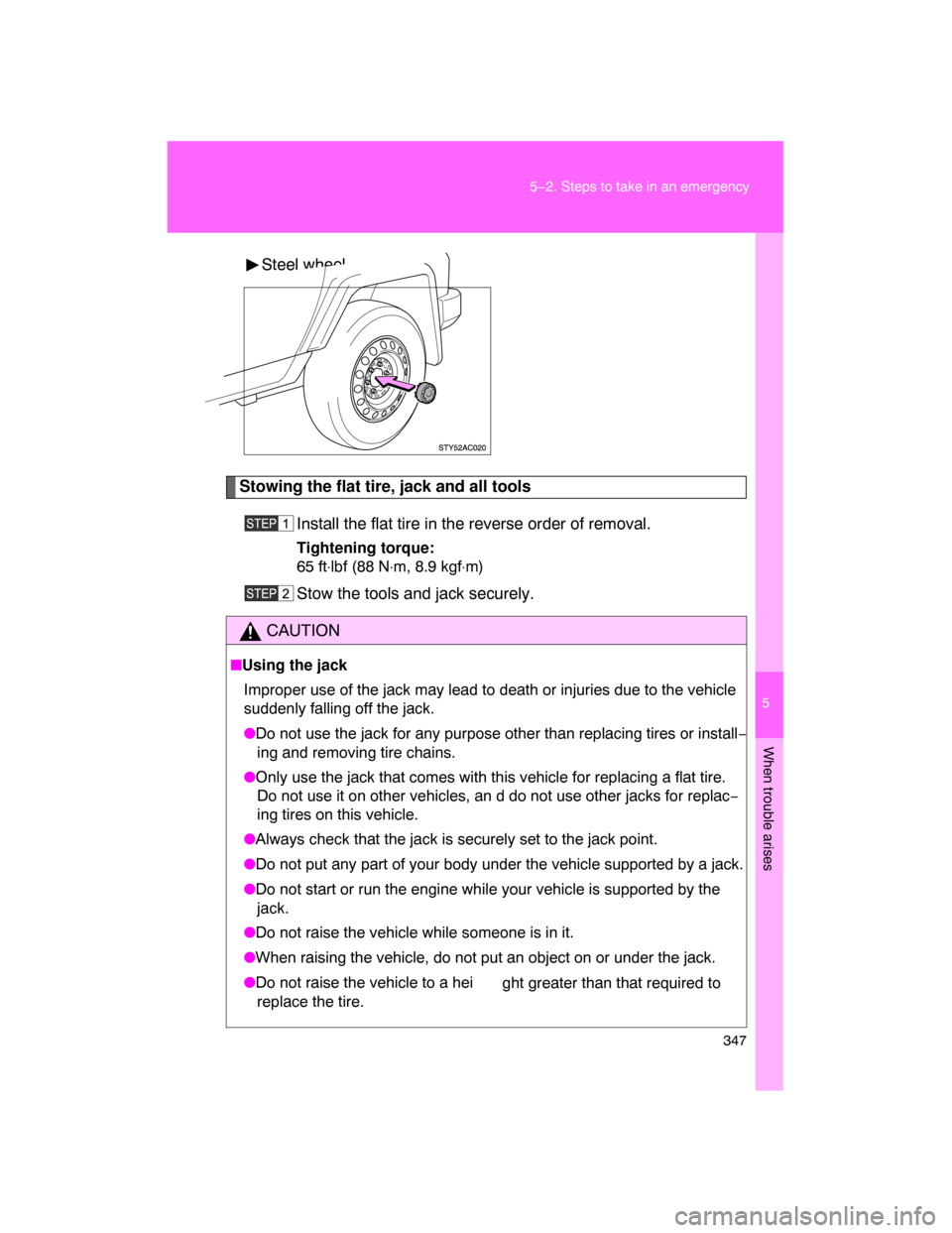
5
When trouble arises
347 5−2. Steps to take in an emergency
Steel wheel
Stowing the flat tire, jack and all tools
Install the flat tire in the reverse order of removal.
Tightening torque:
65 ft⋅lbf (88 N⋅m, 8.9 kgf⋅m)
Stow the tools and jack securely.
CAUTION
�Using the jack
Improper use of the jack may lead to death or injuries due to the vehicle
suddenly falling off the jack.
�Do not use the jack for any purpose other than replacing tires or install−
ing and removing tire chains.
�Only use the jack that comes with this vehicle for replacing a flat tire.
Do not use it on other vehicles, an d do not use other jacks for replac−
ing tires on this vehicle.
�Always check that the jack is securely set to the jack point.
�Do not put any part of your body under the vehicle supported by a jack.
�Do not start or run the engine while your vehicle is supported by the
jack.
�Do not raise the vehicle while someone is in it.
�When raising the vehicle, do not put an object on or under the jack.
�Do not raise the vehicle to a hei
ght greater than that required to
replace the tire.
Page 343 of 400
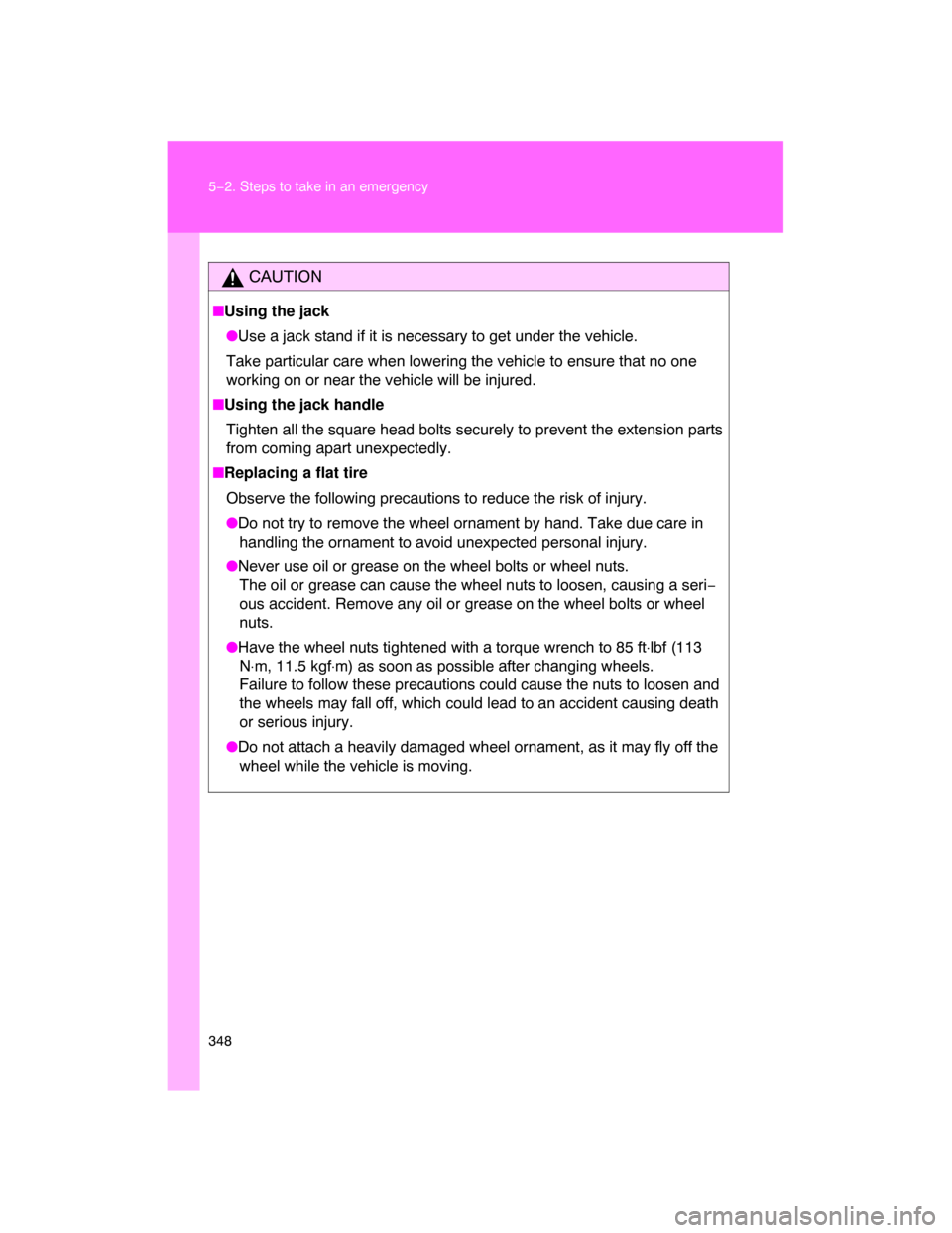
348 5−2. Steps to take in an emergency
CAUTION
�Using the jack
�Use a jack stand if it is necessary to get under the vehicle.
Take particular care when lowering the vehicle to ensure that no one
working on or near the vehicle will be injured.
�Using the jack handle
Tighten all the square head bolts securely to prevent the extension parts
from coming apart unexpectedly.
�Replacing a flat tire
Observe the following precautions to reduce the risk of injury.
�Do not try to remove the wheel ornament by hand. Take due care in
handling the ornament to avoid unexpected personal injury.
�Never use oil or grease on the wheel bolts or wheel nuts.
The oil or grease can cause the wheel nuts to loosen, causing a seri−
ous accident. Remove any oil or grease on the wheel bolts or wheel
nuts.
�Have the wheel nuts tightened with a torque wrench to 85 ft⋅lbf (113
N⋅m, 11.5 kgf⋅m) as soon as possible after changing wheels.
Failure to follow these precautions could cause the nuts to loosen and
the wheels may fall off, which could lead to an accident causing death
or serious injury.
�Do not attach a heavily damaged wheel ornament, as it may fly off the
wheel while the vehicle is moving.
Page 344 of 400
5
When trouble arises
349 5−2. Steps to take in an emergency
NOTICE
�Do not drive the vehicle with a flat tire.
Do not continue driving with a flat tire.
Driving even a short distance with a flat tire can damage the tire and the
wheel beyond repair.
�When replacing the tires
�When removing or fitting the wheels, tires or the tire pressure warning
valve and transmitter, contact your Toyota dealer as the tire pressure
warning valve and transmitter may be damaged if not handled cor−
rectly.
�Replace the grommets for the tire pressure warning valves and trans−
mitters as well.
�To avoid damaging the tire pressure warning valves and transmit�
ters
Do not use liquid sealants on flat tires.
�To prevent damage to the wheel ornament (vehicles with a steel
wheel)
Do not attach wheel ornament to the wheel on the back door.
Page 364 of 400
370 6−1. Specifications
Tires and wheels
Tire size P265/75R16 114T, P265/70R17 113S
Tire inflation pressure
(Recommended cold tire
inflation pressure)Front tires:
32 psi (220 kPa, 2.2 kgf/cm
2 or bar)
Rear tires:
32 psi (220 kPa, 2.2 kgf/cm
2 or bar)
Spare tire:
32 psi (220 kPa, 2.2 kgf/cm
2 or bar)
Wheel size 16 7 J, 17
7 1/2 J
Wheel nut torque 85 ft⋅lbf (113 N⋅m, 11.5 kgf⋅m)
Page 369 of 400
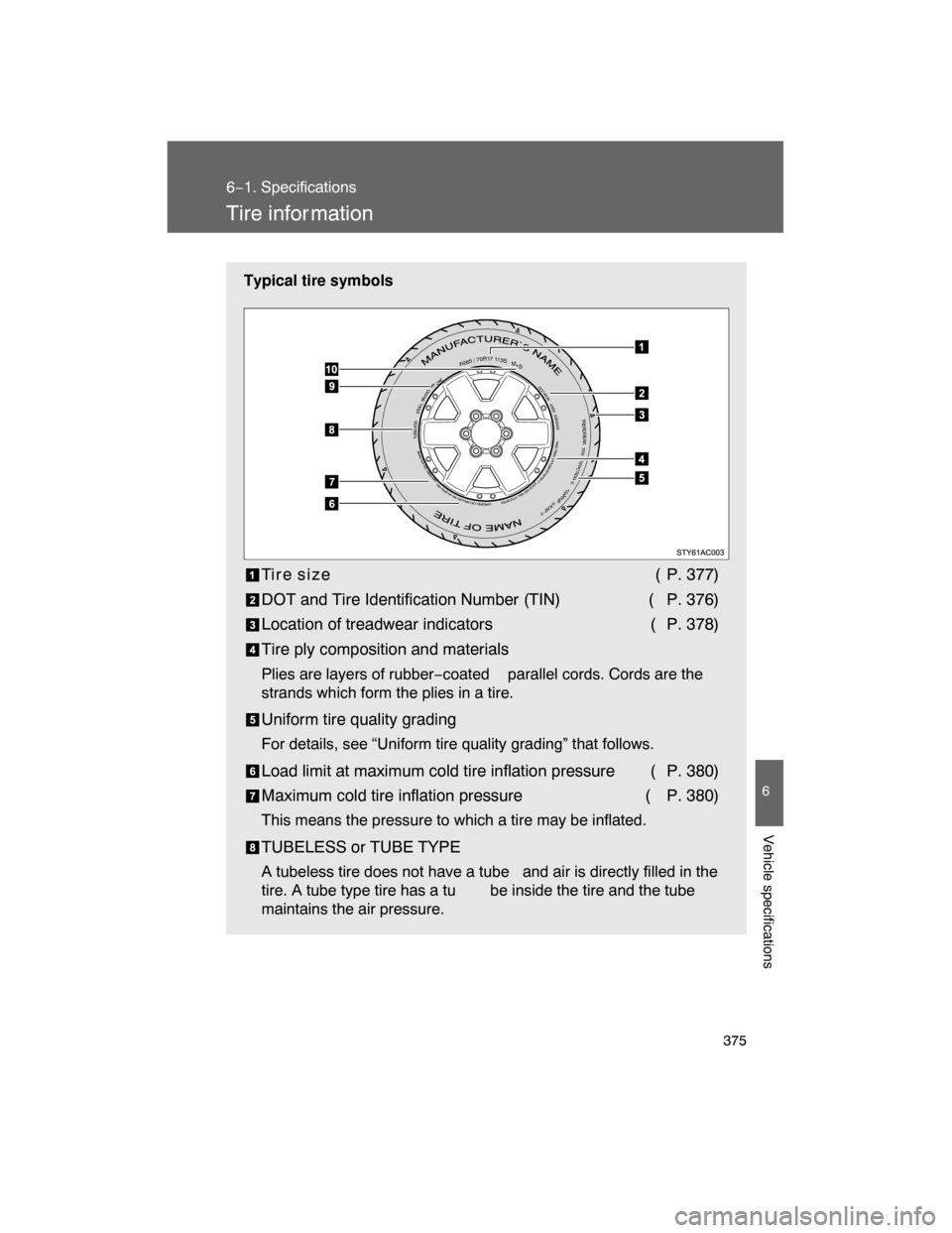
375
6−1. Specifications
6
Vehicle specifications
Tire infor mation
Typical tire symbols
Ti r e s i z e ( P. 377)
DOT and Tire Identification Number (TIN) ( P. 376)
Location of treadwear indicators ( P. 378)
Tire ply composition and materials
Plies are layers of rubber−coated parallel cords. Cords are the
strands which form the plies in a tire.
Uniform tire quality grading
For details, see “Uniform tire quality grading” that follows.
Load limit at maximum cold tire inflation pressure ( P. 380)
Maximum cold tire inflation pressure ( P. 380)
This means the pressure to which a tire may be inflated.
TUBELESS or TUBE TYPE
A tubeless tire does not have a tube and air is directly filled in the
tire. A tube type tire has a tu be inside the tire and the tube
maintains the air pressure.
P
R
I
E
S
T
R
E
A
D
:
2
P
O
L
Y
E
S
T
E
R
+
2
S
T
E
E
L
+
1
NYLONSIDEWALL:2POLYESTER
TREADWE
A
R
X
X
X
T
R
A
C
T
I
O
N
X
T
E
M
P
E
R
ATUREX
TUBE
L
E
S
S
S
T
E
E
L
B
E
L
T
E
D
R
A
DIALDOTXXXXXXXXXXXX
XXX
P265/70R1
7
1
1
3
S
M
+S
STAND
A
R
D
L
O
A
D
M
A
X
.
L
O
A
D
X
X
X
K
G
(
X
X
X
X
L
B
S
)
MAX.PRESS.XXXKPA(XXPSI
)
Page 374 of 400
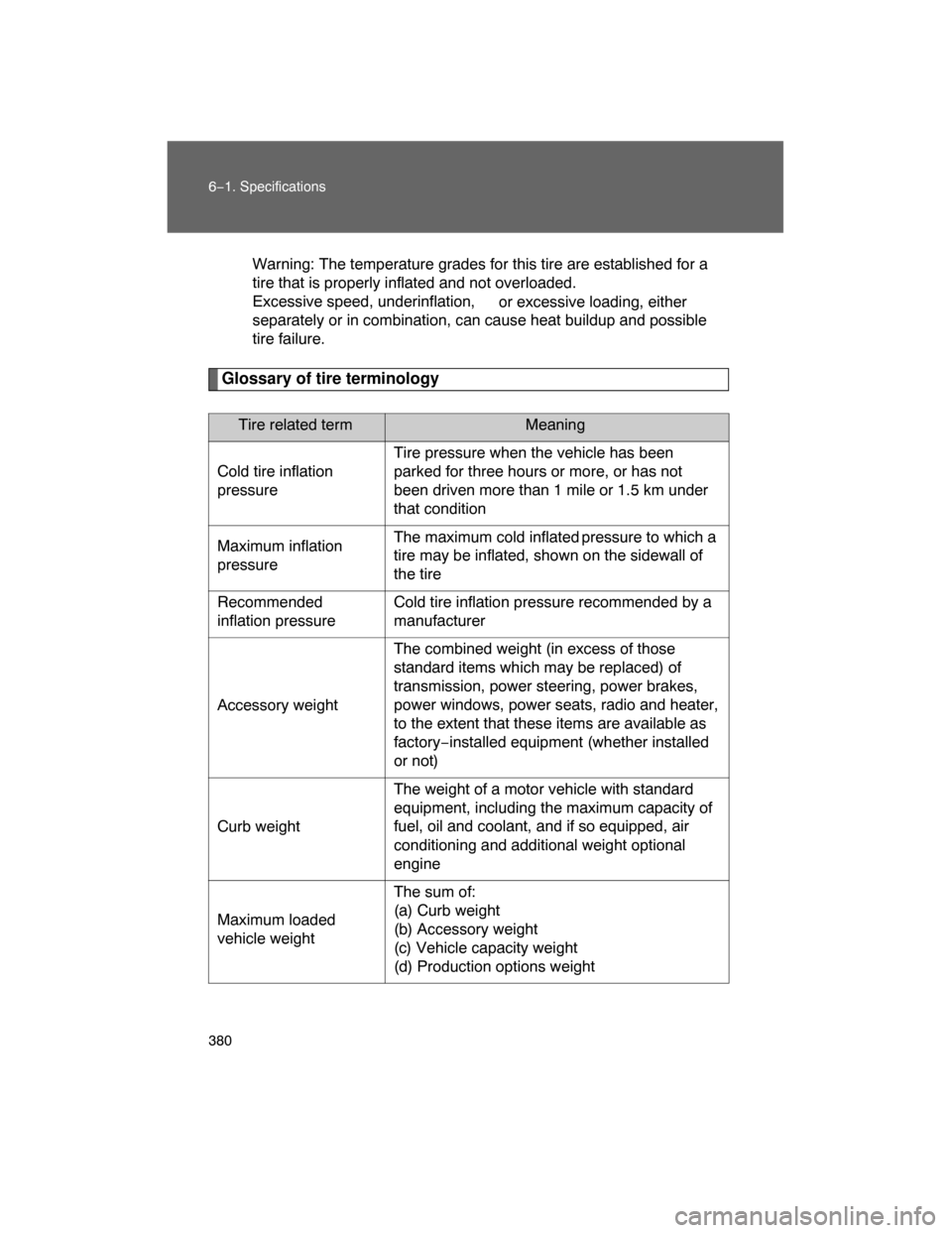
380 6−1. Specifications
Warning: The temperature grades for this tire are established for a
tire that is properly inflated and not overloaded.
Excessive speed, underinflation,
or excessive loading, either
separately or in combination, can cause heat buildup and possible
tire failure.
Glossary of tire terminology
Tire related term Meaning
Cold tire inflation
pressureTire pressure when the vehicle has been
parked for three hours or more, or has not
been driven more than 1 mile or 1.5 km under
that condition
Maximum inflation
pressureThe maximum cold inflated pressure to which a
tire may be inflated, shown on the sidewall of
the tire
Recommended
inflation pressureCold tire inflation pressure recommended by a
manufacturer
Accessory weightThe combined weight (in excess of those
standard items which may be replaced) of
transmission, power steering, power brakes,
power windows, power seats, radio and heater,
to the extent that these items are available as
factory−installed equipment (whether installed
or not)
Curb weightThe weight of a motor vehicle with standard
equipment, including the maximum capacity of
fuel, oil and coolant, and if so equipped, air
conditioning and additional weight optional
engine
Maximum loaded
vehicle weight
The sum of:
(a) Curb weight
(b) Accessory weight
(c) Vehicle capacity weight
(d) Production options weight
Page 376 of 400
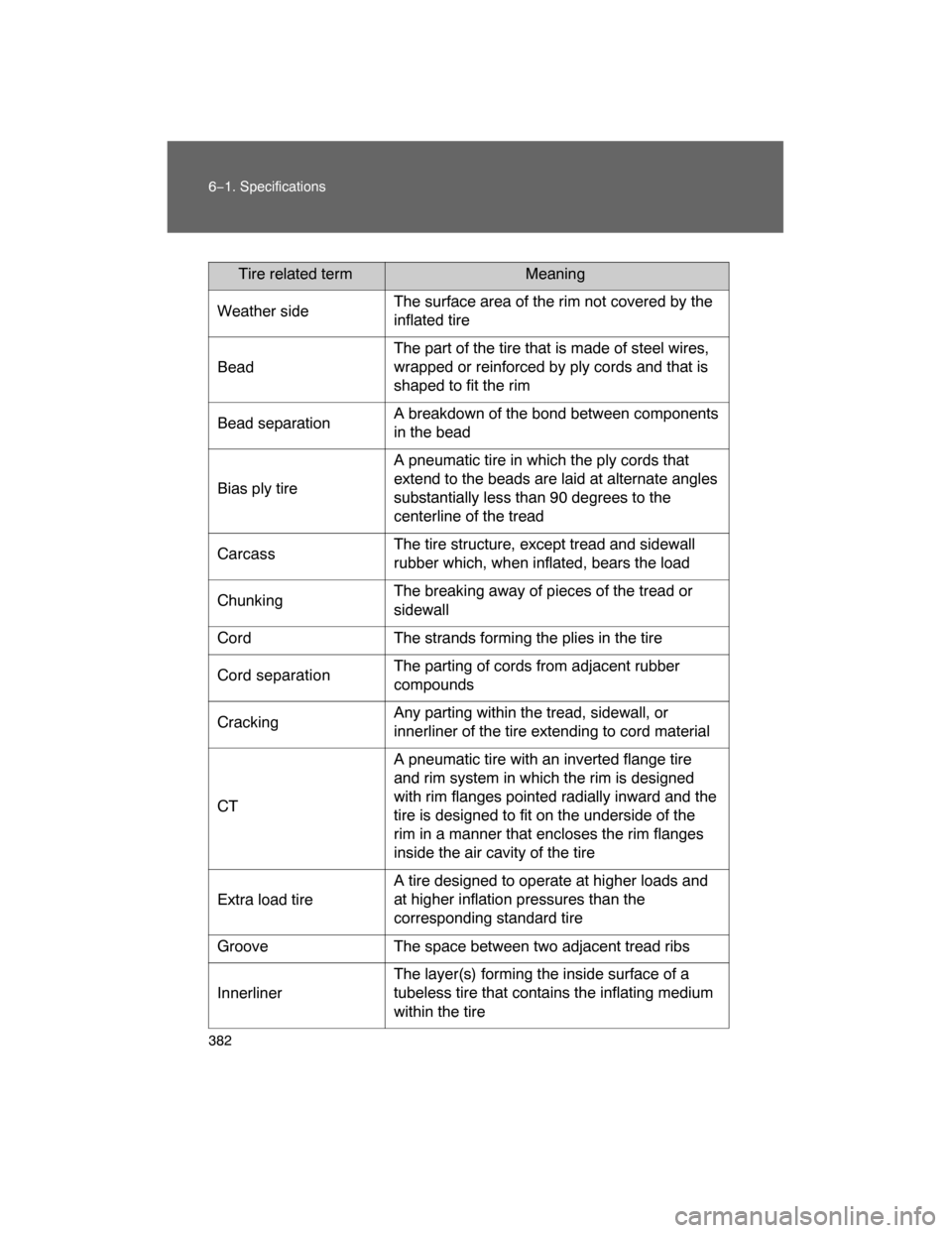
382 6−1. Specifications
Tire related term Meaning
Weather sideThe surface area of the rim not covered by the
inflated tire
BeadThe part of the tire that is made of steel wires,
wrapped or reinforced by ply cords and that is
shaped to fit the rim
Bead separationA breakdown of the bond between components
in the bead
Bias ply tireA pneumatic tire in which the ply cords that
extend to the beads are laid at alternate angles
substantially less than 90 degrees to the
centerline of the tread
CarcassThe tire structure, except tread and sidewall
rubber which, when inflated, bears the load
ChunkingThe breaking away of pieces of the tread or
sidewall
Cord The strands forming the plies in the tire
Cord separationThe parting of cords from adjacent rubber
compounds
CrackingAny parting within the tread, sidewall, or
innerliner of the tire extending to cord material
CTA pneumatic tire with an inverted flange tire
and rim system in which the rim is designed
with rim flanges pointed radially inward and the
tire is designed to fit on the underside of the
rim in a manner that encloses the rim flanges
inside the air cavity of the tire
Extra load tireA tire designed to operate at higher loads and
at higher inflation pressures than the
corresponding standard tire
Groove The space between two adjacent tread ribs
InnerlinerThe layer(s) forming the inside surface of a
tubeless tire that contains the inflating medium
within the tire